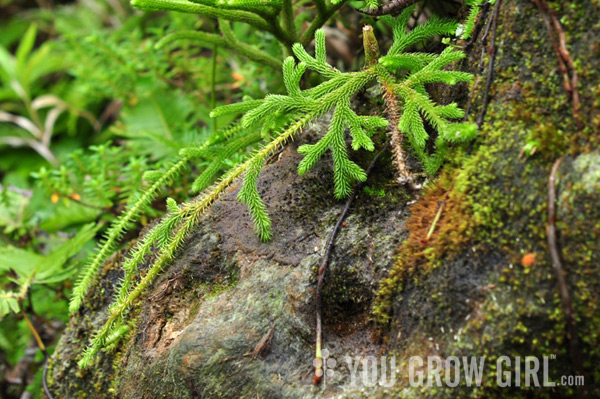
The other day I posted about a datura that wasn’t a datura that I thought had been given the patois name “Agouti Umbrella,” but is not in fact the “Agouti Umbrella” even though it certainly looks like it could be one.
The fern-like moss shown in the above photo is the real “Agouti Umbrella” aka “Parasol Agouti.” In my defence, it doesn’t seem to make much sense does it? After all, the Brugmansia, which incidentally is labelled Datura in one of the books I have been using as a reference (confused yet?) is shaped like a large parasol covered in drooping umbrellas.
But, no.
This teeny weeny little plant called Sellaginella that I saw growing in the forest, at a friend’s place up in the Valley (here is another source of contention. The idea that one would travel uphill to arrive at a valley continues to confound me), and as seen in the photo above, taken on our hike to the Boiling Lake, is the real “Agouti Umbrella”.
Huh?
This has proven to be another lesson in the importance of scientific names. Case in point, I was introduced to several plants on the trip that I haven’t been able to show you because I can not identify them. Davin and I spent about three hours collectively attempting to identify a plant that we can’t find a single reference to both online or in books. All I have is the Patois or Creole name, and even that can get very confusing. A single plant can have a different Patois name depending on which island you are on, or even which community on any given island you happen to be visiting at the time. For example, there are nine varieties of yam on Dominica, and different Patois names for any given variety from village to village. As a result, I’ve pretty much given up trying to identify yams. It’s enough that I know the genus.
Added to that is the fact that I didn’t always hear the Patois correctly. I grew up with a grandmother who spoke Patois or “Kweyol” as it is sometimes called, (although she would never teach me) and who spoke with a pretty typical Dominican accent, and I still couldn’t understand what people were saying at times. It is a beautiful accent by-the-way. Very lyrical and sing-songy. So while I have my notes to refer back to, there have been many times when my spelling was way off the mark.
One of the books I have been using to make identifications, “Caribbean Wild Plants and Their Uses” by Penelope N. Honychurch, is helpful in that the index is organized by the scientific, English common, and Creole names. But it’s a small book and just about any plant that grows in the Caribbean is growing somewhere on Dominica. That’s a lot of plants to cover. They really need their own, comprehensive book.
Wow. I knew that was a Brugmansia too and just didn’t notice. They are surprisingly similar though, but I’ve noticed that Datura flowers point up while Brugmansia’s droop down. Datura is actually known as a weed in California, not sure about how it’s viewed elsewhere. They are very pretty for being considered weeds!
I recognized the photo immediately, but had no idea what it actually was. I photographed that plant at the freshwater lake in Dominica in 2003 :)
It’s actually a species of Lycopodium, not Selaginella.
Ron:
Can you explain your reasoning for that identification? I’d very much like to know that I have the right identification.
In Dominica this was identified to me as “Parasol Agouti”, which is identified in the book I have (which crosses Creole names with botanical names) as a species of selaginella. Lycopodiums and Selaginella are awfully similar…
Hi Gayla, the two can have somewhat similar appearances, but the best way I can describe the major difference between them is that selaginellas don’t stretch out on rope-like branches as they grow (like the plant pictured above). They instead tend to be slow creepers, huddled up together and short-branched in their growth.
I could, obviously, be wrong about saying the plant in question is a lycopodium (especially with your book reference)…but it looks nearly identical to many of the lycopodiums species native in my area as well as some of the tropical ones I have worked with.